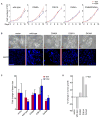Chd5 requires PHD-mediated histone 3 binding for tumor suppression
- PMID: 23318260
- PMCID: PMC3575599
- DOI: 10.1016/j.celrep.2012.12.009
Chd5 requires PHD-mediated histone 3 binding for tumor suppression
Abstract
Chromodomain Helicase DNA binding protein 5 (CHD5) is a tumor suppressor mapping to 1p36, a genomic region that is frequently deleted in human cancer. Although CHD5 belongs to the CHD family of chromatin-remodeling proteins, whether its tumor-suppressive role involves an interaction with chromatin is unknown. Here we report that Chd5 binds the unmodified N terminus of H3 through its tandem plant homeodomains (PHDs). Genome-wide chromatin immunoprecipitation studies reveal preferential binding of Chd5 to loci lacking the active mark H3K4me3 and also identify Chd5 targets implicated in cancer. Chd5 mutations that abrogate H3 binding are unable to inhibit proliferation or transcriptionally modulate target genes, which leads to tumorigenesis in vivo. Unlike wild-type Chd5, Chd5-PHD mutants are unable to induce differentiation or efficiently suppress the growth of human neuroblastoma in vivo. Our work defines Chd5 as an N-terminally unmodified H3-binding protein and provides functional evidence that this interaction orchestrates chromatin-mediated transcriptional programs critical for tumor suppression.
Copyright © 2013 The Authors. Published by Elsevier Inc. All rights reserved.
Figures




Similar articles
-
Multivalent recognition of histone tails by the PHD fingers of CHD5.Biochemistry. 2012 Aug 21;51(33):6534-44. doi: 10.1021/bi3006972. Epub 2012 Aug 8. Biochemistry. 2012. PMID: 22834704 Free PMC article.
-
Chromodomain helicase DNA binding protein 5 plays a tumor suppressor role in human breast cancer.Breast Cancer Res. 2012 May 8;14(3):R73. doi: 10.1186/bcr3182. Breast Cancer Res. 2012. PMID: 22569290 Free PMC article.
-
Role of CHD5 in human cancers: 10 years later.Cancer Res. 2014 Feb 1;74(3):652-8. doi: 10.1158/0008-5472.CAN-13-3056. Epub 2014 Jan 13. Cancer Res. 2014. PMID: 24419087 Free PMC article. Review.
-
Molecular mechanism of histone H3K4me3 recognition by plant homeodomain of ING2.Nature. 2006 Jul 6;442(7098):100-3. doi: 10.1038/nature04814. Epub 2006 May 21. Nature. 2006. PMID: 16728977 Free PMC article.
-
The quest for the 1p36 tumor suppressor.Cancer Res. 2008 Apr 15;68(8):2551-6. doi: 10.1158/0008-5472.CAN-07-2095. Cancer Res. 2008. PMID: 18413720 Free PMC article. Review.
Cited by
-
Chromodomain Helicase DNA-Binding Protein 5 Inhibits Renal Cell Carcinoma Tumorigenesis by Activation of the p53 and RB Pathways.Biomed Res Int. 2020 Sep 28;2020:5425612. doi: 10.1155/2020/5425612. eCollection 2020. Biomed Res Int. 2020. PMID: 33062682 Free PMC article.
-
Dangerous liaisons: interplay between SWI/SNF, NuRD, and Polycomb in chromatin regulation and cancer.Genes Dev. 2019 Aug 1;33(15-16):936-959. doi: 10.1101/gad.326066.119. Epub 2019 May 23. Genes Dev. 2019. PMID: 31123059 Free PMC article. Review.
-
The chromatin remodeling factor CHD5 is a transcriptional repressor of WEE1.PLoS One. 2014 Sep 23;9(9):e108066. doi: 10.1371/journal.pone.0108066. eCollection 2014. PLoS One. 2014. PMID: 25247294 Free PMC article.
-
Polycomb Repression without Bristles: Facultative Heterochromatin and Genome Stability in Fungi.Genes (Basel). 2020 Jun 9;11(6):638. doi: 10.3390/genes11060638. Genes (Basel). 2020. PMID: 32527036 Free PMC article. Review.
-
Integrative genomic and transcriptomic analysis for pinpointing recurrent alterations of plant homeodomain genes and their clinical significance in breast cancer.Oncotarget. 2017 Feb 21;8(8):13099-13115. doi: 10.18632/oncotarget.14402. Oncotarget. 2017. PMID: 28055972 Free PMC article.
References
-
- Bagchi A, Papazoglu C, Wu Y, Capurso D, Brodt M, Francis D, Bredel M, Vogel H, Mills AA. CHD5 is a tumor suppressor at human 1p36. Cell. 2007;128:459–475. - PubMed
-
- Barski A, Cuddapah S, Cui K, Roh TY, Schones DE, Wang Z, Wei G, Chepelev I, Zhao K. High-resolution profiling of histone methylations in the human genome. Cell. 2007;129:823–837. - PubMed
Publication types
MeSH terms
Substances
Grants and funding
LinkOut - more resources
Full Text Sources
Other Literature Sources
Molecular Biology Databases

